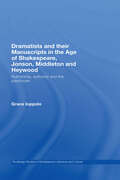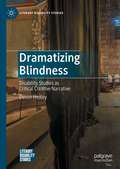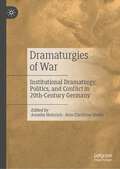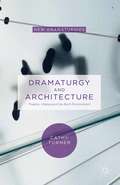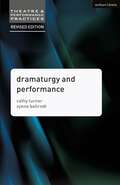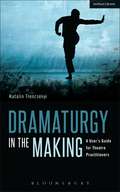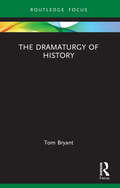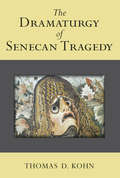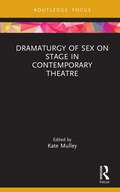- Table View
- List View
Dramatists and their Manuscripts in the Age of Shakespeare, Jonson, Middleton and Heywood: Authorship, Authority and the Playhouse (Routledge Studies in Renaissance Literature and Culture)
by Grace IoppoloThis book presents new evidence about the ways in which English Renaissance dramatists such as William Shakespeare, Ben Jonson, Thomas Heywood, John Fletcher and Thomas Middleton composed their plays and the degree to which they participated in the dissemination of their texts to theatrical audiences. Grace Ioppolo argues that the path of the transmission of the text was not linear, from author to censor to playhouse to audience - as has been universally argued by scholars - but circular. Extant dramatic manuscripts, theatre records and accounts, as well as authorial contracts, memoirs, receipts and other archival evidence, are used to prove that the text returned to the author at various stages, including during rehearsal and after performance. This monograph provides much new information and case studies, and is a fascinating contribution to the fields of Shakespeare studies, English Renaissance drama studies, manuscript studies, textual study and bibliography and theatre history.
Dramatizing Blindness: Disability Studies as Critical Creative Narrative (Literary Disability Studies)
by Devon HealeyDramatizing Blindness: Disability Studies as Critical Creative Narrative engages with the cultural meanings and movements of blindness. This book addresses how blindness is lived in particular contexts—in offices of ophthalmology and psychiatry, in classrooms of higher education, in accessibility service offices, on the street, and at home. Taking the form of a play written in five acts, the narrative dramatizes how the main character’s blindness is conceived of in the world and in the self. Each act includes an analysis where blind studies is explored in relation to disability studies. This work reveals the performative enactment of blindness that is lived in the public as well as in the private corners of the self, demonstrating how blindness is a form of perception. Devon Healey’s work orients to blindness as a necessary and creative feature of the sensorium and shows how blindness is a form of perception.
Dramaturgies of Interweaving: Engaging Audiences in an Entangled World (Routledge Advances in Theatre & Performance Studies)
by Erika Fischer-Lichte, Christel Weiler and Torsten JostDramaturgies of Interweaving explores present-day dramaturgies that interweave performance cultures in the fields of theater, performance, dance, and other arts. Merging strategies of audience engagement originating in different cultures, dramaturgies of interweaving are creative methods of theater and art-making that seek to address audiences across cultures, making them uniquely suitable for shaping people’s experiences of our entangled world. Presenting in-depth case studies from across the globe, spanning Australia, China, Germany, India, Iran, Japan, Singapore, Taiwan, Vietnam, the US, and the UK, this book investigates how dramaturgies of interweaving are conceived, applied, and received today. Featuring critical analyses by scholars—as well as workshop reports and artworks by renowned artists—this book examines dramaturgies of interweaving from multiple locations and perspectives, thus revealing their distinct complexities and immense potential. Ideal for scholars, students, and practitioners of theater, performance, dramaturgy, and devising, Dramaturgies of Interweaving opens up an innovative perspective on today’s breathtaking plurality of dramaturgical practices of interweaving in theater, performance, dance, and other arts, such as curation and landscape design.
Dramaturgies of Interweaving: Engaging Audiences in an Entangled World (Routledge Advances in Theatre & Performance Studies)
by Erika Fischer-Lichte Christel Weiler Torsten JostDramaturgies of Interweaving explores present-day dramaturgies that interweave performance cultures in the fields of theater, performance, dance, and other arts. Merging strategies of audience engagement originating in different cultures, dramaturgies of interweaving are creative methods of theater and art-making that seek to address audiences across cultures, making them uniquely suitable for shaping people’s experiences of our entangled world. Presenting in-depth case studies from across the globe, spanning Australia, China, Germany, India, Iran, Japan, Singapore, Taiwan, Vietnam, the US, and the UK, this book investigates how dramaturgies of interweaving are conceived, applied, and received today. Featuring critical analyses by scholars—as well as workshop reports and artworks by renowned artists—this book examines dramaturgies of interweaving from multiple locations and perspectives, thus revealing their distinct complexities and immense potential. Ideal for scholars, students, and practitioners of theater, performance, dramaturgy, and devising, Dramaturgies of Interweaving opens up an innovative perspective on today’s breathtaking plurality of dramaturgical practices of interweaving in theater, performance, dance, and other arts, such as curation and landscape design.
Dramaturgies of Love in Romeo and Juliet: Word, Music, and Dance (Routledge Studies in Shakespeare)
by Jonas KellermannBringing together current intermedial discourses on Shakespeare, music, and dance with the affective turn in the humanities, Dramaturgies of Love in Romeo and Juliet offers a unique and highly innovative transdisciplinary discussion of ‘unspeakable’ love in one of the most famous love stories in literary history: the tragic romance of Romeo and Juliet. Through in-depth case studies and historical contextualisation, this book showcases how the ‘woes that no words can sound’ of Shakespeare’s iconic lovers nevertheless have found expression not only in his verbal poetry, but also in non-verbal adaptations of the play in 19th-century symphonic music and 20th- and 21st-century theatre dance. Combining methodological approaches from diverse disciplines, including affect theory, musicology and dance studies, this study opens up a new perspective onto the artistic representation of love, defining amorous emotion as a generically transformative constellation of dialogic performativity. To explore how this constellation has become manifest across the arts, this book analyses and compares dramatic, musical, and choreographic dramatisations of love in William Shakespeare’s early modern tragedy, French composer Hector Berlioz’s dramatic symphony Roméo et Juliette (1839), and the staging of Berlioz’s symphony by German contemporary choreographer Sasha Waltz for the Paris Opera Ballet (2007).
Dramaturgies of Love in Romeo and Juliet: Word, Music, and Dance (Routledge Studies in Shakespeare)
by Jonas KellermannBringing together current intermedial discourses on Shakespeare, music, and dance with the affective turn in the humanities, Dramaturgies of Love in Romeo and Juliet offers a unique and highly innovative transdisciplinary discussion of ‘unspeakable’ love in one of the most famous love stories in literary history: the tragic romance of Romeo and Juliet. Through in-depth case studies and historical contextualisation, this book showcases how the ‘woes that no words can sound’ of Shakespeare’s iconic lovers nevertheless have found expression not only in his verbal poetry, but also in non-verbal adaptations of the play in 19th-century symphonic music and 20th- and 21st-century theatre dance. Combining methodological approaches from diverse disciplines, including affect theory, musicology and dance studies, this study opens up a new perspective onto the artistic representation of love, defining amorous emotion as a generically transformative constellation of dialogic performativity. To explore how this constellation has become manifest across the arts, this book analyses and compares dramatic, musical, and choreographic dramatisations of love in William Shakespeare’s early modern tragedy, French composer Hector Berlioz’s dramatic symphony Roméo et Juliette (1839), and the staging of Berlioz’s symphony by German contemporary choreographer Sasha Waltz for the Paris Opera Ballet (2007).
Dramaturgies of War: Institutional Dramaturgy, Politics, and Conflict in 20th-Century Germany
by Anselm Heinrich Ann-Christine SimkeThis book examines the institutional contexts of dramaturgical practices in the changing political landscape of 20th century Germany. Through wide-ranging case studies, it discusses the way in which operationalised modes of action, legal frameworks and an established profession have shaped dramaturgical practice and thus links to current debates around the “institutional turn” in theatre and performance studies. German theatre represents a rich and well-chosen field as it is here where the role of the dramaturg was first created and where dramaturgy played a significantly politicised role in the changing political systems of the 20th century. The volume represents an important addition to a growing field of work on dramaturgy by contributing to a historical contextualisation of current practice. In doing so, it understands dramaturgy not only as a process which occurs in rehearsal rooms and writers’ studies, but one that has far wider institutional and political implications.
Dramaturgy and Architecture: Theatre, Utopia and the Built Environment (New Dramaturgies)
by Cathy TurnerDramaturgy and Architecture approaches modern and postmodern theatre's contribution to the way we think about the buildings and spaces we inhabit. It discusses in detail ways in which theatre and performance have critiqued and intervened in everyday spaces, modelled our dreams or fears and made proposals for the future.
Dramaturgy and Performance (Theatre and Performance Practices)
by Cathy Turner Synne BehrndtOutlining different perspectives, this classic and field-defining text introduces 'dramaturgy' as a critical concept and a practical process in an accessible and engaging style. The revised edition includes a new introduction and afterword which provides insight into contemporary developments and future directions of scholarship.
Dramaturgy: The Basics (The Basics)
by Anne M. Hamilton Walter Byongsok ChonDramaturgy: The Basics introduces the art of dramaturgy, explaining how dramaturgy works, what a dramaturg is, and how to appreciate their unique contribution to theatre-making. A wide-ranging account of the role of this vital element of theatre helps students and aspiring performance makers to apply dramaturgy to a full spectrum of theatrical disciplines. This guidebook teaches dramatic theories and script analysis as essential skills for aspiring dramaturgs and illustrates the various methods of reading for specific functions of dramaturgy. Dramaturgy: The Basics offers practical step-by-step instructions on how to practice production dramaturgy, dramaturgy of new work, translation, adaptation, devised theatre, site-specific theatre, literary management, criticism, editing, producing, and dramaturgical innovation, with detailed questions to consider at each stage of the process. This book aims to help students develop a dramaturgical mindset, enabling them to build a critical, inquisitive, and socially conscious perspective that is beneficial in all professions and relationships. Resource lists, further reading guides, and chapter summaries make this an outstanding guidebook. An essential read for anyone hoping to make, understand, or discuss theatre, Dramaturgy: The Basics provides a clear, accessible resource for approaching this integral but often misunderstood facet of theatre-making.
Dramaturgy: The Basics (The Basics)
by Anne M. Hamilton Walter Byongsok ChonDramaturgy: The Basics introduces the art of dramaturgy, explaining how dramaturgy works, what a dramaturg is, and how to appreciate their unique contribution to theatre-making. A wide-ranging account of the role of this vital element of theatre helps students and aspiring performance makers to apply dramaturgy to a full spectrum of theatrical disciplines. This guidebook teaches dramatic theories and script analysis as essential skills for aspiring dramaturgs and illustrates the various methods of reading for specific functions of dramaturgy. Dramaturgy: The Basics offers practical step-by-step instructions on how to practice production dramaturgy, dramaturgy of new work, translation, adaptation, devised theatre, site-specific theatre, literary management, criticism, editing, producing, and dramaturgical innovation, with detailed questions to consider at each stage of the process. This book aims to help students develop a dramaturgical mindset, enabling them to build a critical, inquisitive, and socially conscious perspective that is beneficial in all professions and relationships. Resource lists, further reading guides, and chapter summaries make this an outstanding guidebook. An essential read for anyone hoping to make, understand, or discuss theatre, Dramaturgy: The Basics provides a clear, accessible resource for approaching this integral but often misunderstood facet of theatre-making.
Dramaturgy in the Making: A User's Guide for Theatre Practitioners (Performance Books)
by Katalin Trencsényi Geoffrey ProehlDramaturgy in the Making maps contemporary dramaturgical practices in various settings of theatre-making and dance to reveal the different ways that dramaturgs work today. It provides a thorough survey of three major areas of practice - institutional dramaturgy, production dramaturgy and dance dramaturgy - with each illustrated through a range of case studies that illuminate methodology and which will assist practitioners in developing their own 'dramaturgical toolbox'.In tracing the development of the role of the dramaturg, the author explores the contribution of Lessing, Brecht and Tynan, foundational figures who shaped the practice. She excavates the historical and theoretical contexts for each strand of the work, uniquely offering a history of dance dramaturgy and its associated theories.Based on extensive research, the volume features material from the author's interviews with fifty eminent professionals from Europe and North America, including: Robert Blacker, Jack Bradley, DD Kugler, Ruth Little and Hildegard De Vuyst. Through these, a detailed and precise insight is provided into dramaturgical processes at organisations such as the Akram Khan Company, les ballets C de la B (Gent), the National Theatre and the Royal Court (London), the Schaubühne (Berlin) and The Sundance Institute Theatre Lab (Utah), among others.Dramaturgy in the Making will prove indispensable to anyone working in theatre or wanting to better understand the dramaturgical processes in performance-making today. The book features a foreword by Geoff Proehl, author of Toward a Dramaturgical Sensibility: Landscape and Journey.
Dramaturgy in the Making: A User's Guide for Theatre Practitioners (Performance Books)
by Katalin Trencsényi Geoffrey ProehlDramaturgy in the Making maps contemporary dramaturgical practices in various settings of theatre-making and dance to reveal the different ways that dramaturgs work today. It provides a thorough survey of three major areas of practice - institutional dramaturgy, production dramaturgy and dance dramaturgy - with each illustrated through a range of case studies that illuminate methodology and which will assist practitioners in developing their own 'dramaturgical toolbox'.In tracing the development of the role of the dramaturg, the author explores the contribution of Lessing, Brecht and Tynan, foundational figures who shaped the practice. She excavates the historical and theoretical contexts for each strand of the work, uniquely offering a history of dance dramaturgy and its associated theories.Based on extensive research, the volume features material from the author's interviews with fifty eminent professionals from Europe and North America, including: Robert Blacker, Jack Bradley, DD Kugler, Ruth Little and Hildegard De Vuyst. Through these, a detailed and precise insight is provided into dramaturgical processes at organisations such as the Akram Khan Company, les ballets C de la B (Gent), the National Theatre and the Royal Court (London), the Schaubühne (Berlin) and The Sundance Institute Theatre Lab (Utah), among others.Dramaturgy in the Making will prove indispensable to anyone working in theatre or wanting to better understand the dramaturgical processes in performance-making today. The book features a foreword by Geoff Proehl, author of Toward a Dramaturgical Sensibility: Landscape and Journey.
The Dramaturgy of Commedia dell'Arte
by Olly CrickThis book examines Commedia dell'Arte as a performative genre, and one that should be analysed through the framework of dramaturgy and dramaturgical practice. This volume examines the way Commedia has been explored in the twentieth and twenty-first centuries, and details its reinventors’ dramaturgic approaches, both focusing in on specific examples such as Jacques Lecoq, Dario Fo and Antonio Fava, and also suggesting how modern discoveries may aid the study of historical performance practice. It also discusses how audiences read and receive masks; the relationship between the different masked and unmasked roles; the range of performance activities that come under the umbrella term ‘improvisation’; the performative construction of a role performed ‘live’ from a scenario; the role of language and embodied locality in performance; and the performative relationship between performative commedia and literary tragicomedy. Its focus is dramaturgy, and so it may be read both as a text describing various theatrical practices from 1946 onwards and as a way of creating one’s own contemporary Commedia practice. It is an important read for any student or scholar of Commedia dell'Arte and theatre historians grappling with the status of this unique and influential performance form.
The Dramaturgy of Commedia dell'Arte
by Olly CrickThis book examines Commedia dell'Arte as a performative genre, and one that should be analysed through the framework of dramaturgy and dramaturgical practice. This volume examines the way Commedia has been explored in the twentieth and twenty-first centuries, and details its reinventors’ dramaturgic approaches, both focusing in on specific examples such as Jacques Lecoq, Dario Fo and Antonio Fava, and also suggesting how modern discoveries may aid the study of historical performance practice. It also discusses how audiences read and receive masks; the relationship between the different masked and unmasked roles; the range of performance activities that come under the umbrella term ‘improvisation’; the performative construction of a role performed ‘live’ from a scenario; the role of language and embodied locality in performance; and the performative relationship between performative commedia and literary tragicomedy. Its focus is dramaturgy, and so it may be read both as a text describing various theatrical practices from 1946 onwards and as a way of creating one’s own contemporary Commedia practice. It is an important read for any student or scholar of Commedia dell'Arte and theatre historians grappling with the status of this unique and influential performance form.
The Dramaturgy of History (Focus on Dramaturgy)
by Tom BryantIn this book, dramaturg Tom Bryant shares with readers and writers his insights into the process of historical adaptation. The book uses case studies from Bryant's collaborations with playwrights on successful Broadway and regional productions to work through the fundamental questions of historical adaptation: Why do you want to adapt history? For what purpose? What is your approach? How does that approach affect the portrayal of events? How does that choice by the playwright and the dramaturg then determine the framing and focus in the story, the selection of the key events and the choice of characters? What is the meaning you want the audience to take away from the events? How is your adaptation of past events relevant to contemporary times? In addition, the author explores the moral and ethical responsibilities involved for the dramaturg and the playwright in the adaptation of history and how issues of diversity, equity and inclusion impact the presentation of historical material. This is an indispensable resource for anyone whose craft brings them to the task of adapting historical material for the stage—in postgraduate work, teaching or professional practice.
The Dramaturgy of History (Focus on Dramaturgy)
by Tom BryantIn this book, dramaturg Tom Bryant shares with readers and writers his insights into the process of historical adaptation. The book uses case studies from Bryant's collaborations with playwrights on successful Broadway and regional productions to work through the fundamental questions of historical adaptation: Why do you want to adapt history? For what purpose? What is your approach? How does that approach affect the portrayal of events? How does that choice by the playwright and the dramaturg then determine the framing and focus in the story, the selection of the key events and the choice of characters? What is the meaning you want the audience to take away from the events? How is your adaptation of past events relevant to contemporary times? In addition, the author explores the moral and ethical responsibilities involved for the dramaturg and the playwright in the adaptation of history and how issues of diversity, equity and inclusion impact the presentation of historical material. This is an indispensable resource for anyone whose craft brings them to the task of adapting historical material for the stage—in postgraduate work, teaching or professional practice.
Dramaturgy of Migration: Staging Multilingual Encounters in Contemporary Theatre (Focus on Dramaturgy)
by Yana Meerzon Katharina PewnyDramaturgy of Migration: Staging Multilingual Encounters in Contemporary Theatre examines the function of dramaturgy and the role of the dramaturg in making a theatre performance situated at the crossroads of multiple theatre forms and performative devices. This book explores how these forms and devices are employed, challenged, experimented with, and reflected upon in the work of migrant theatre by performance and dance artists. Meerzon and Pewny ask: What impact do peoples’ movement between continents, countries, cultures, and languages have on the process of meaning production in plays about migration created by migrant artists? What dramaturgical devices do migrant artists employ when they work in the context of multilingual production, with the texts written in many languages, and when staging performances that target multicultural and multilingual theatregoers? And, finally, how do the new multilingual practices of theatre writing and performance meet and transform the existing practices of postdramatic dramaturgies? By considering these questions in a global context, the editors explore the overlapping complexities of migratory performances with both range and depth. Ideal for scholars, students, and practitioners of theatre, dramaturgy, and devising, Dramaturgy of Migration expresses not only the practicalities of migratory performances but also the emotional responses of the artists who stage them.
Dramaturgy of Migration: Staging Multilingual Encounters in Contemporary Theatre (Focus on Dramaturgy)
by Yana Meerzon Katharina PewnyDramaturgy of Migration: Staging Multilingual Encounters in Contemporary Theatre examines the function of dramaturgy and the role of the dramaturg in making a theatre performance situated at the crossroads of multiple theatre forms and performative devices. This book explores how these forms and devices are employed, challenged, experimented with, and reflected upon in the work of migrant theatre by performance and dance artists. Meerzon and Pewny ask: What impact do peoples’ movement between continents, countries, cultures, and languages have on the process of meaning production in plays about migration created by migrant artists? What dramaturgical devices do migrant artists employ when they work in the context of multilingual production, with the texts written in many languages, and when staging performances that target multicultural and multilingual theatregoers? And, finally, how do the new multilingual practices of theatre writing and performance meet and transform the existing practices of postdramatic dramaturgies? By considering these questions in a global context, the editors explore the overlapping complexities of migratory performances with both range and depth. Ideal for scholars, students, and practitioners of theatre, dramaturgy, and devising, Dramaturgy of Migration expresses not only the practicalities of migratory performances but also the emotional responses of the artists who stage them.
The Dramaturgy of Performing Science: New Work in Interdisciplinary Contexts (ISSN)
by Jules Odendahl-JamesThis is a concise survey of new play projects that bring together the worlds of science and performance, and the benefits that dramaturgical praxis can bring to both disciplines.Three approaches common to both performance and science – collaboration, experimentation, and interpretation – are reflected in a series of case studies that demonstrate the ways in which dramaturgical tools can inform the wider public about scientific knowledge and practice, provide a truly reciprocal model of co-operation in collaboration that happens early on in the research process, and inspire the creation of new dramatic forms that enact, rather than translate, the dynamics of scientific research.Part of the Routledge Focus on Dramaturgy series, this is a vital account of collaborative work for scholars and practitioners of theatre and performance, as well as readers across the sciences.
The Dramaturgy of Performing Science: New Work in Interdisciplinary Contexts (ISSN)
by Jules Odendahl-JamesThis is a concise survey of new play projects that bring together the worlds of science and performance, and the benefits that dramaturgical praxis can bring to both disciplines.Three approaches common to both performance and science – collaboration, experimentation, and interpretation – are reflected in a series of case studies that demonstrate the ways in which dramaturgical tools can inform the wider public about scientific knowledge and practice, provide a truly reciprocal model of co-operation in collaboration that happens early on in the research process, and inspire the creation of new dramatic forms that enact, rather than translate, the dynamics of scientific research.Part of the Routledge Focus on Dramaturgy series, this is a vital account of collaborative work for scholars and practitioners of theatre and performance, as well as readers across the sciences.
The Dramaturgy of Senecan Tragedy
by Thomas KohnThe first-century Roman tragedies of Seneca, like all ancient drama, do not contain the sort of external stage directions that we are accustomed to today; nevertheless, a careful reading of the plays reveals such stage business as entrances, exits, setting, sound effects, emotions of the characters, etc. The Dramaturgy of Senecan Tragedy teases out these dramaturgical elements in Seneca's work and uses them both to aid in the interpretation of the plays and to show the playwright's artistry. Thomas D. Kohn provides a detailed overview of the corpus, laying the groundwork for appreciating Seneca's techniques in the individual dramas. Each of the chapters explores an individual tragedy in detail, discussing the dramatis personae and examining how the roles would be distributed among a limited number of actors, as well as the identity of the Chorus. The Dramaturgy of Senecan Tragedymakes a compelling argument for Seneca as an artist and a dramaturg in the true sense of the word: "a maker of drama." Regardless of whether Seneca composed his plays for full-blown theatrical staging, a fictive theater of the mind, or something in between, Kohn demonstrates that he displays a consistency and a careful attentiveness to details of performance. While other scholars have applied this type of performance criticism to individual tragedies or scenes, this is the first comprehensive study of all the plays in twenty-five years, and the first ever to consider not just stagecraft, but also metatheatrical issues such as the significant distribution of roles among a limited number of actors, in addition to the emotional states of the characters. Scholars of classics and theater, along with those looking to stage the plays, will find much of interest in this study.
Dramaturgy of Sex on Stage in Contemporary Theatre (Focus on Dramaturgy)
by Kate MulleyDramaturgy of Sex on Stage in Contemporary Theatre explores the dramaturgy of sex in contemporary works for the stage in the social, cultural and historical context of the time and place during which they were written and performed. Comprising chapters by writers from across North America and Europe, the book covers an expansive range of plays, musicals and dance performances, from Broadway to the Fringe, from post-AIDS epidemic to post-COVID-19 pandemic. Analysing these intimate moments—both textually and as staged—through an intersectional and critical lens illuminates the way power structures are maintained and codified, and how they can be queered and dismantled onstage and off. This examination of depictions of sex on stage attempts to understand from a dramaturgical and sociological perspective how these depictions have developed over time, and how the rise of intimacy directors has responded to the changes within the contemporary theatrical landscape and in the world at large. This is an essential companion for any scholar or practitioner looking to stage, discuss or understand intimacy in performance.
Dramaturgy of Sex on Stage in Contemporary Theatre (Focus on Dramaturgy)
Dramaturgy of Sex on Stage in Contemporary Theatre explores the dramaturgy of sex in contemporary works for the stage in the social, cultural and historical context of the time and place during which they were written and performed. Comprising chapters by writers from across North America and Europe, the book covers an expansive range of plays, musicals and dance performances, from Broadway to the Fringe, from post-AIDS epidemic to post-COVID-19 pandemic. Analysing these intimate moments—both textually and as staged—through an intersectional and critical lens illuminates the way power structures are maintained and codified, and how they can be queered and dismantled onstage and off. This examination of depictions of sex on stage attempts to understand from a dramaturgical and sociological perspective how these depictions have developed over time, and how the rise of intimacy directors has responded to the changes within the contemporary theatrical landscape and in the world at large. This is an essential companion for any scholar or practitioner looking to stage, discuss or understand intimacy in performance.
The Dramaturgy of Space (Theatre Makers)
by Ramón GrifferoIn Ramón Griffero's seminal work, The Dramaturgy of Space, the playwright and director describes his aesthetic philosophy and theoretical approach to theatrical creation, illustrating his theory through practical application in a series of exercises.As well as touching upon some of Griffero's own work, like Cinema utopia (1985), Tus deseos en fragmentos (2003), Fin del eclipse (2007) and El azar de la fiesta (1992), this book also reinforces the practicality of Griffero's concepts through a series of online videos, breaking down each exercise and allowing readers to engage with the effects of his celebrated approach.Published here in English for the first time, in a translation by the leading expert on Griffero, The Dramaturgy of Space reveals the internationally renowned Chilean artist's thought process, and how his practice has influenced the theatrical, political, and social context, from the Pinochet dictatorship to the present day.
